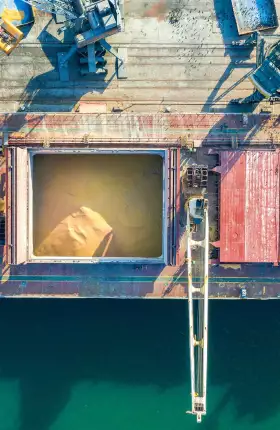The unprecedented volatility in US tariffs is putting pressure not only on manufacturers and retailers but also on financial services providers. Among financial firms, the US insurance industry is being hit hard, as the higher tariffs affect everything from insurers’ claims severity and underwriting to investment returns and profit margins.
The tariffs are reshaping the economics of insurance, raising costs even as they suppress demand. Although insurance remains a necessity for many, rising premiums could push customers toward cheaper and less comprehensive coverage. Compounding issues is the sharp increase in the cost of resolving claims, especially in auto and property lines that rely on imported parts and materials from industries such as steel, aluminum, lumber, and electronics. While the economic uncertainty might boost interest in trade credit insurance, insurers are proceeding cautiously, often restricting coverage limits to manage escalating risks.
Tariffs are reshaping the economics of insurance, raising costs even as they suppress demand.
The tariffs are also impacting insurers’ investment portfolios. As market volatility has risen since the tariffs were announced, insurers are seeing a reduction in their investment returns. Merger activity, along with initial public offerings, has ground to a halt. This creates a troubling financial squeeze: rising operational costs paired with diminishing investment returns.
Despite these challenges, supply chain shifts could create opportunities for insurance companies that think and act strategically. While trade volumes could decline in the near term, the redistribution of supply chains might increase regional demand and create more need for domestic coverage in sectors tied to onshoring. As businesses relocate production and source domestically, insurers that respond proactively to these changes could find growth in these markets.
The Impact on Property and Casualty
The rising tariffs may be felt most immediately in the Property & Casualty (P&C) sector. Carriers could incur higher claims costs in personal and commercial policies, particularly where imported vehicles, building materials, or equipment are involved. Auto and property insurance might be the first to experience the effects, but the repercussions could ripple across other commercial lines, such as inland marine and liability coverages.
The tariffs reintroduce cost pressures just when some carriers had begun lowering rates after years of unpredictable claims costs and pressures on capital reserves. The industry could refocus on ensuring that rates are adequate to cover costs and protect profit margins.
At the same time, other headwinds persist: high rates of legal activity make casualty claims more expensive, while severe storms and catastrophic disasters continue to drag down the P&C sector. It’s unclear whether the recent softening in commercial lines will continue, and any economic slowdown could further weigh on exposure-based premiums. That’s particularly true for those rated on payrolls or revenues, which could create additional revenue challenges for carriers.
Market volatility could affect P&C insurers’ investment portfolios, depending on their mix of assets. P&C companies typically allocate roughly 25% of their investments to equities and 55% to bonds—which means long-tail commercial lines have been most affected by the gyrations in the fixed-income markets. However, the sector’s strong capital levels position it to handle moderate fluctuations.
The impact of these challenges on individual insurers depends on their product portfolio, geographic exposure, rate adequacy, reserve adequacy, policy terms and conditions, and capital management.
Auto Lines Take the First Hit
Because more than half of US vehicles and parts are imported, the new tariffs increase the cost to repair or replace damaged vehicles, creating pressure on carriers. Rising repair costs impact both minor claims, such as fender benders and cracked windshields, to more severe claims that come close to warranting a full writeoff. This situation presents a challenge for both first-party auto coverage (of the policyholder's vehicle) and third-party coverage (of other vehicles that may be damaged).
Supply chain constraints and tariff concerns are also driving up used car prices, as they did during the pandemic. When new vehicle production slows or becomes more costly, more people look to buy used vehicles. This increased demand then shrinks the available supply and inflates prices further.
This overall situation creates a distinct set of problems for carriers. For minor claims, the rising costs of parts inflate repair bills. And because used cars are so expensive, replacing a damaged vehicle becomes less attractive. This often compels carriers to repair vehicles they might otherwise write off. But the higher price of replacement vehicles discourages companies from writing off badly damaged cars. This squeezes insurers from both sides: higher repair costs for many claims and a reluctance to pay for expensive replacements for heavily damaged vehicles.
Adding to these difficulties, the increasing complexity of modern cars makes repairs more expensive and time-consuming. Furthermore, the effects of tariffs extend beyond physical damage coverage, as the rising cost of medical goods and services exacerbates the financial burden of injury-related claims.
Carriers with short-duration policies can adjust prices quickly, while those with longer-term obligations face greater margin pressure. For new sales, higher vehicle prices may reduce overall purchases or push buyers toward American-made vehicles—affecting insurers’ portfolio mix, underwriting strategy, and customer segmentation.
Key Trends to Watch
Rising Claims Severity and Loss Costs. Heavy reliance on imported auto parts can make repairs more expensive across personal and commercial lines, with used car inflation and part shortages forcing more vehicles to be declared total losses.
Need for Higher Premiums. Carriers may need to raise rates to stay profitable, favoring those that can do so with precision while keeping prices competitive and retaining customers.
More Fraud Risk. Economic pressure from tariffs could lead to more fraudulent claims, further driving up the cost of claims.
Slower Claims Resolutions. Supply chain delays could mean claims take longer to resolve, increasing the paperwork and costs for carriers.
Changes in the Customer Mix. Tariffs could slow new vehicle sales or push buyers toward American-made models, altering insurers’ customer mix, risk profiles, and customer segmentation.
Property Is Also Under Pressure
US construction and reconstruction still depend heavily on imported materials, including roofing systems, HVAC components, and appliances from Asia and Europe. Tariffs on these goods could raise home reconstruction costs by 5% to 15%, depending on location and structure type. For example, 23% of finished steel in the US—now subject to a 25% tariff— is imported, and an ongoing section 232 investigation may lead to increases on lumber and other building products.
This situation puts pressure on many aspects of property claims--including dwelling coverage, additional living expenses (ALE), and ordinance and law provisions. Commercial property faces similar risk, particularly habitational portfolios and builder’s risk policies in states with high levels of development. Delays in sourcing materials could extend business interruption claims and raise litigation risk related to project timelines or habitability. Higher claims costs could also draw scrutiny in reinsurance markets, particularly for catastrophe programs, with reinsurers re-evaluating loss assumptions and pricing adequacy.
Despite these challenges, potential shifts toward local manufacturing and domestic supply chains could create demand for insurance coverage for warehousing, factories, and infrastructure—offering tailwinds for certain commercial property lines.
Key Trends to Watch
- Higher Costs for Personal Claims. Tariffs could increase repair and rebuilding costs, affecting dwelling, additional living expenses, and ordinance coverages.
- More Business Disruptions and Lawsuits. Material shortages have the potential to delay projects and slow the construction market’s growth, resulting in more business interruption claims, fewer builder’s risk policies, and more legal disputes.
- Changes in Reinsurance. Higher claims costs could lead to greater paid losses in catastrophe insurance, with reinsurers scrutinizing loss assumptions and pricing adequacy more closely.
- Reduced Coverage Levels. Higher premium costs may lead businesses to reduce coverage and retain more risk, slowing premium growth.
- Opportunities from Reshoring. Potential shifts toward local manufacturing might increase demand for domestic insurance coverage, creating positive momentum in commercial property lines.
Short-term property insurance already has felt the impact of higher inflation, with rising material and labor costs making claims more expensive. This often forces personal insurers to seek rate increases—and leads carriers to adjust pricing, policy terms, and coverage limits. By comparison, long-tail lines see the effects more gradually, driven by wage growth, medical inflation, and legal costs. These costs typically show up later through increased reserve requirements. The final impact could depend on how high inflation climbs and how long it lasts.
Broader Commercial Impacts
Besides auto and property, tariffs may affect a range of other commercial and specialty insurance lines. Marine and cargo insurers could face increased claims tied to delays, rerouting, and spoilage risks—especially for time-sensitive shipments. Trade disruption also has the capacity to impact inland marine policies covering warehousing and logistics. Moreover, declining trade volumes may reduce marine premium pools, echoing patterns seen during the 2019 US–China tariff cycle, when North American marine cargo premiums fell 15%.
Trade credit is another area at risk. As global uncertainty mounts, demand for coverage on receivables is increasing. However, this growth could be limited by insurer caution, particularly around expanding credit limits in volatile markets.
In workers’ compensation, higher tariffs on pharmaceuticals and medical equipment may lead to higher medical and wage replacement costs over time. Notably, if tariffs contribute to a broader economic slowdown, claim frequency rises—as financially struggling employees are more likely to report injuries. This has happened in prior downturns and should be watched closely.
Instability in global supply chains and financial markets could heighten both the frequency and severity of claims in certain liability lines, including directors and officers (D&O) and errors and omissions (E&O). As economic conditions evolve, insurers may need to keep a close eye on any ripple effects across their broader commercial portfolios.
Key Trends to Watch
- Shrinking Marine Premium Pools. Trade volume decreases have the potential to reduce marine premium pools, particularly in cargo lines.
- More, and More Expensive, Marine Cargo Claims. The shipping and logistics disruptions raise the risk of rerouting, delays, and spoilage.
- Trade Credit Supply-Demand Mismatch. Growing demand for receivables coverage may exceed insurers' willingness to extend credit.
- Changes in Workers’ Comp Claims. Economic stress may lead to more claims, even if each claim costs about the same.
- Higher Liability Risks. D&O and E&O exposures could rise amid regulatory uncertainty and financial stress.
The Impact on Life and Annuity
While P&C insurers feel the effects of the trade tariffs first, life and annuity (L&A) insurers are not entirely untouched. The ripple effects of macroeconomic volatility—especially if tariffs spark higher inflation or market turbulence—could affect investment fees and returns, consumer behavior, and product demand.
For life and annuity carriers, the effects may not always be straightforward and might even vary across products. While the observed increase in financial market volatility might reduce sales of equity-linked products such as variable annuities or variable universal life, it could boost sales of guaranteed-return products like fixed annuities and whole life.
Higher inflation and lower consumer confidence could also reduce demand owing to the negative impact on wealth—and prompt policyholders to let their coverage lapse. However, this is not the full picture. Times of great uncertainty, like the tech bubble and the great financial crisis, have also been times of opportunity for the life insurance salesforce to discuss how to reduce volatility in their clients’ portfolios.
Key Trends to Watch
- Investment losses may affect private equity–backed insurers. Tariff-driven market instability could lead to losses for insurers backed by private equity or alternative asset managers, which typically hold higher-risk, less-liquid assets.
- Policy surrenders may rise as consumers seek liquidity. Heightened economic pressures might drive higher lapse rates as policyholders need access to cash.
- Demand could shift toward lower-risk products. As economic uncertainty grows, demand may shift toward fixed and guaranteed products, while interest in equity-linked offerings—even with downside protection—may decrease.
Responding with Speed and Precision
As was the case during past inflationary periods, the most resilient carriers are those that quickly add tariff-related scenarios into their enterprise risk and capital planning. These insurers might tailor their products to the needs of inflation-sensitive customers—adding features such as flexible premiums, adjusted coverage triggers, or built-in cost protections. They could also pursue growth in emerging domestic markets tied to onshoring, manufacturing investment, and supply chain reconfiguration.
To succeed, US P&C insurers must become more cost-efficient to offset rising claims severity and margin pressure, use real-time data and agile pricing to quickly adjust filings and rate plans, and adapt their scenario planning so they are more resilient as trade policies change.
These capabilities are especially critical in short-tail lines like auto and property, where cost pressures appear quickly and compound rapidly. In the long run, insurers should account for trade policy volatility across investment portfolios, global supply exposures, and capital allocation decisions. Carriers with robust pricing, claims, and supply chain analytics could be best positioned to lead the market—and thrive—amid uncertainty.
Effectively anticipating and responding to trade policy shifts requires more than reactive adjustments. A strategic foresight process helps organizations interpret market signals and make faster decisions, sometimes even before the shift occurs. BCG’s strategic foresight process consists of these five phases:
- Decide where to look. Identify the key forces and megatrends likely to shape the future and create mechanisms to detect early signals of disruption.
- Understand what to look for. Analyze forward-looking data to uncover emerging trends in customer needs, competitor dynamics, technology, and policy.
- Separate signals from noise. Focus on the few signals that have the potential to meaningfully impact your business.
- Interpret the signals. Evaluate the business implications of these signals; conducting effective “so what” analyses is a powerful differentiator.
- Determine what to do with what you’ve found. Develop proactive strategies to address or capitalize on potential disruptions.
To navigate the shifting implications of tariffs, part of the larger strategic foresight process involves a systematic approach to analyzing strategic risks—consisting of four key steps companies should take to assess both risks to their strategy and risks arising from it. This approach begins with building a fact base to identify the moves that have the potential to deliver the most impact. The next step is developing three to five stretched-but-plausible scenario narratives, using decision trees to define key trigger points, early warning signposts, and leading indicators. The third step is conducting “war game” and contingency planning simulations to assess how competitors might respond under varying scenarios, mapping key decision points, and potential business impacts. The final step is to synthesize the learnings from the first three activities to develop an actionable strategy that includes optionality and decision points with activation criteria. This includes flagging the early warning signals that could affect each business unit, creating a tariff playbook with no-regret and contingent responses to these signals, and developing a stakeholder engagement strategy.
A tariff playbook addresses key strategic levers during tariff shifts. Such a playbook includes:
- Pricing and Product Strategy. Analyzing customer sensitivity to price changes and designing lower-cost or modular product offerings.
- Customer Retention and Communication. Identifying at-risk policyholders and launching clear, targeted communication campaigns to maintain engagement.
- Operational Efficiency. Streamlining processes to reduce costs and preserve margins in a rising tariff environment.
- Sales and Distribution Support. Equipping agents with the tools, training, and messaging needed to navigate product or pricing changes.
- Regulatory Readiness. Ensuring all tariff adjustments are compliant with applicable regulations and supported by robust documentation.
- Competitive Intelligence. Tracking post-tariff performance and monitoring competitor pricing to inform timely adjustments.
While tariffs represent today’s pressing geopolitical disruption, they are merely one manifestation of a broader need for strategic foresight. Forward-thinking insurers must institutionalize this approach to address multiple emerging challenges—from generative AI and driverless vehicles to extreme weather events, sustainability demands, and high rates of legal activity.
None of these future risks exist neatly in actuarial tables or traditional risk registers. Instead, they require a fundamental shift in how the industry deals with uncertainty. By embracing strategic foresight and strategic risk processes, insurers can learn to not just react to disruption—but to anticipate and leverage change more effectively.






